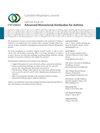特发性肺纤维化中的抗粘液病毒耐药性蛋白-1免疫球蛋白A自身抗体
IF 2.1
4区 医学
Q3 RESPIRATORY SYSTEM
引用次数: 0
摘要
背景我们先前分析了特发性肺纤维化(IPF)、特发性非特异性间质性肺炎(iNSIP)患者和健康对照组的血清自身抗体水平,并确定抗粘病毒抵抗蛋白-1(MX1)的自身抗体是iNSIP中的一种特异性自身抗体。我们发现,在非IPF特发性间质性肺炎患者中,较高的抗MX1自身抗体水平是良好预后的重要预测因素。在这项回顾性研究中,我们试图阐明抗MX1自身抗体在IPF中的预后意义。方法我们通过酶联免疫吸附试验测定了71例根据2018年IPF指南诊断的IPF患者在诊断时收集的血清中的抗MX1免疫球蛋白(Ig)G、IgA和IgM自身抗体水平。计算每个病例的性别年龄生理学(GAP)指数。结果研究人群(59名男性和12名女性)的中位年龄为67岁。血清抗MX1 IgG和IgA自身抗体水平与GAP分期呈正相关(p<0.05)。单变量Cox比例风险回归分析未发现抗MX1 IgG、IgA或IgM自身抗体水平升高是一个重要的预后因素;然而,较高的抗MX1-IgA自身抗体水平预示着在调整GAP分期(p=0.030)、强迫肺活量百分比和改良医学研究委员会评分(p=0.018)后的生存率显著降低。抗MX1-IgG自身抗体和IgM自身抗体都不能预测这些调整后的生存。结论血清抗MX1 IgA自身抗体水平是影响IPF预后的重要因素。需要进一步的研究来阐明这种自身抗体在IPF中的病理生理作用。本文章由计算机程序翻译,如有差异,请以英文原文为准。
Anti-Myxovirus Resistance Protein-1 Immunoglobulin A Autoantibody in Idiopathic Pulmonary Fibrosis
Background We have previously analysed serum autoantibody levels in patients with idiopathic pulmonary fibrosis (IPF), idiopathic nonspecific interstitial pneumonia (iNSIP), and healthy controls and identified the autoantibody against anti-myxovirus resistance protein-1 (MX1) to be a specific autoantibody in iNSIP. We found that a higher anti-MX1 autoantibody level was a significant predictor of a good prognosis in patients with non-IPF idiopathic interstitial pneumonias. In this retrospective study, we sought to clarify the prognostic significance of the anti-MX1 autoantibody in IPF. Methods We measured anti-MX1 immunoglobulin (Ig) G, IgA, and IgM autoantibody levels by enzyme-linked immunosorbent assay in serum collected at the time of diagnosis from 71 patients with IPF diagnosed according to the 2018 IPF guideline. The gender-age-physiology (GAP) index was calculated in each case. Results The study population (59 men and 12 women) had a median age of 67 years. Serum anti-MX1 IgG and IgA autoantibody levels correlated positively with GAP stage (p < 0.05). Univariate Cox proportional hazards regression analysis did not identify an elevated anti-MX1 IgG, IgA, or IgM autoantibody level as a significant prognostic factor; however, a higher anti-MX1 IgA autoantibody level heralded significantly poorer survival after adjustment for GAP stage (p=0.030) and for percent forced vital capacity and modified Medical Research Council score (p=0.018). Neither the anti-MX1 IgG autoantibody nor the IgM autoantibody could predict survival after these adjustments. Conclusions The serum anti-MX1 IgA autoantibody level is a significant prognostic factor in IPF. Further studies are needed to clarify the pathophysiological role of this autoantibody in IPF.
求助全文
通过发布文献求助,成功后即可免费获取论文全文。
去求助
来源期刊

Canadian respiratory journal
医学-呼吸系统
CiteScore
4.20
自引率
0.00%
发文量
61
审稿时长
6-12 weeks
期刊介绍:
Canadian Respiratory Journal is a peer-reviewed, Open Access journal that aims to provide a multidisciplinary forum for research in all areas of respiratory medicine. The journal publishes original research articles, review articles, and clinical studies related to asthma, allergy, COPD, non-invasive ventilation, therapeutic intervention, lung cancer, airway and lung infections, as well as any other respiratory diseases.
 求助内容:
求助内容: 应助结果提醒方式:
应助结果提醒方式:


